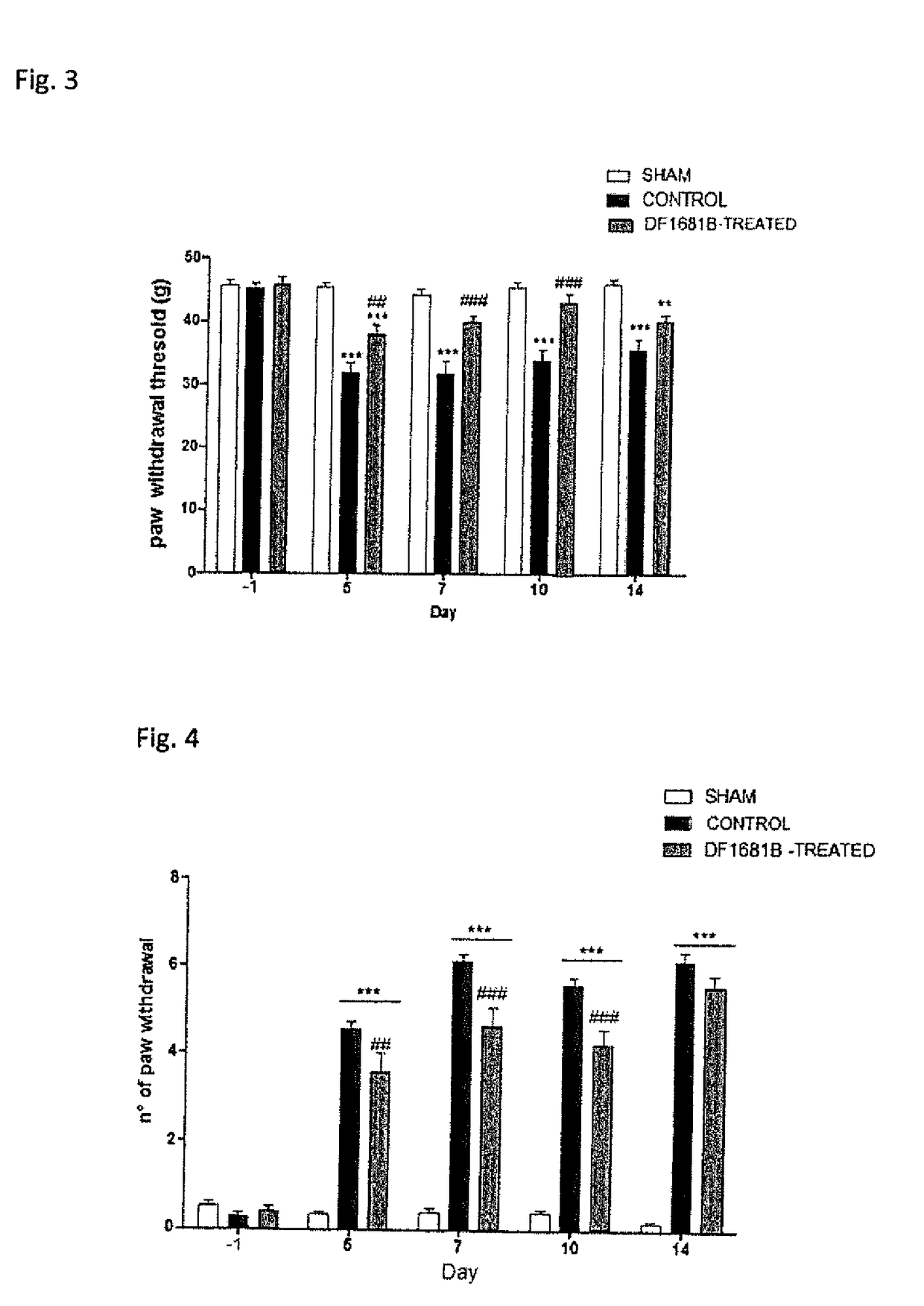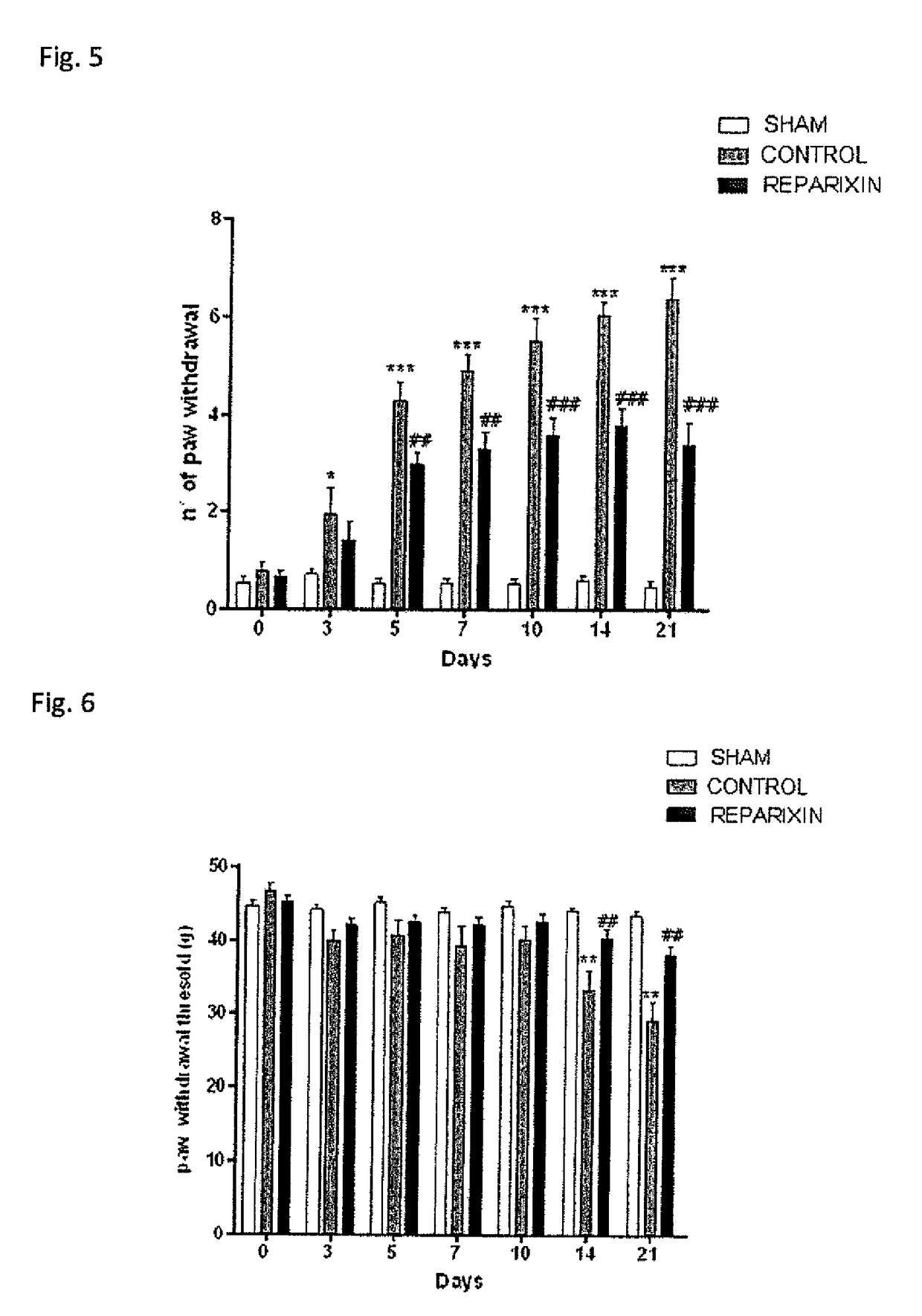Il-8 inhibitors for use in the treatment of chemotherapy-induced peripheral neuropathy
a technology of inhibitors and inhibitors, applied in the direction of amide active ingredients, drug compositions, anhydride/acid/halide active ingredients, etc., can solve the problems of affecting the survival of patients, sensory disruption leading to painful paresthesia in all affected patients, and chemotherapy has been reported to cause both peripheral neuropathy and ocular complications, so as to reduce or prevent symptoms.
- Summary
- Abstract
- Description
- Claims
- Application Information
AI Technical Summary
Benefits of technology
Problems solved by technology
Method used
Image
Examples
example 1
Effect of DF2726A in Paclitaxel-Induced Mechanical and Cold Allodynia
[0134]Mechanical and cold allodynia were evaluated in three groups of animals: SHAM, which did not receive paclitaxel nor any other treatment, Control, which received paclitaxel and vehicle, and DF2726A-treated, which received paclitaxel and DF2726A. Administration of treatments was carried out according to the protocol described in Methods.
[0135]Following paclitaxel administration animals in both Control and DF2726A-treated groups showed an evident mechanical and cold allodynia as compared to sham rats (FIG. 1 and FIG. 2).
[0136]In particular, in the Control group, in the Dynamic Plantar Aesthesiometer test, paw withdrawal threshold resulted significantly reduced at day 5, 7, 10 and 14, evidence of the onset of neuropathy (FIG. 1, black columns).
[0137]In the same group, in the cold allodynia test, the numbers of paw withdrawal threshold resulted significantly increased at days 5, 7, 10 and 14, evidencing the onset ...
example 2
Effect of DF1681B in Paclitaxel-Induced Mechanical and Cold Allodynia
[0142]Mechanical and cold allodynia were evaluated in three groups of animals: Sham, which did not receive paclitaxel nor any other treatment, Control, which received paclitaxel and vehicle and DF1681B-treated, which received Paclitaxel and DF1681B. Administration of treatments was carried out according to the protocol described in Methods.
[0143]Following paclitaxel administration animals in both Control and DF1681B-treated groups showed an evident mechanical and cold allodynia as compared to Sham rats (FIGS. 3 and 4). In particular, in the Control group, in the DPA test, paw withdrawal threshold, resulted significantly reduced at day 5, 7, 10 and 14, evidence of neuropathy (FIG. 3).
[0144]Animals treated with DF1681B showed a significant reduction of mechanical allodynia at days 5 (P<0.01), 7 (P<0.001) and 10 (P<0.001) compared to animals treated with vehicle. No additional antiallodynic effect was measured on day ...
example 3
Effect of DF1681B in Oxaliplatin-Induced Mechanical and Cold Allodynia
[0145]Mechanical and cold allodynia were evaluated in three groups of animals: Sham, which did not receive oxaliplatin nor any other treatment, Control, which received oxaliplatin and vehicle, and DF1681B-treated, which received oxaliplatin and DF1681B. Administration of treatments was carried out according to the protocol described in Methods.
[0146]In cold allodynia experiments, animals treated with vehicle showed a number of paw withdrawal significantly increased at all experimental time-points (3, 5, 7, 10, 14, 21 day) due to neuropathy (FIG. 5), DF1681B did not show antiallodynic effect at day 3 (FIG. 5), while at days 5, 7, 10, 14, 21, it showed a significant reduction of cold allodynia (FIG. 5).
[0147]In mechanical allodynia experiments, paw withdrawal threshold resulted significantly reduced only at day 14 and 21, (FIG. 6); at these days DF1681B showed a significant antiallodynic effect (FIG. 6).
PUM
| Property | Measurement | Unit |
|---|---|---|
| temperature | aaaaa | aaaaa |
| concentration | aaaaa | aaaaa |
| concentration | aaaaa | aaaaa |
Abstract
Description
Claims
Application Information
 Login to View More
Login to View More - R&D
- Intellectual Property
- Life Sciences
- Materials
- Tech Scout
- Unparalleled Data Quality
- Higher Quality Content
- 60% Fewer Hallucinations
Browse by: Latest US Patents, China's latest patents, Technical Efficacy Thesaurus, Application Domain, Technology Topic, Popular Technical Reports.
© 2025 PatSnap. All rights reserved.Legal|Privacy policy|Modern Slavery Act Transparency Statement|Sitemap|About US| Contact US: help@patsnap.com



